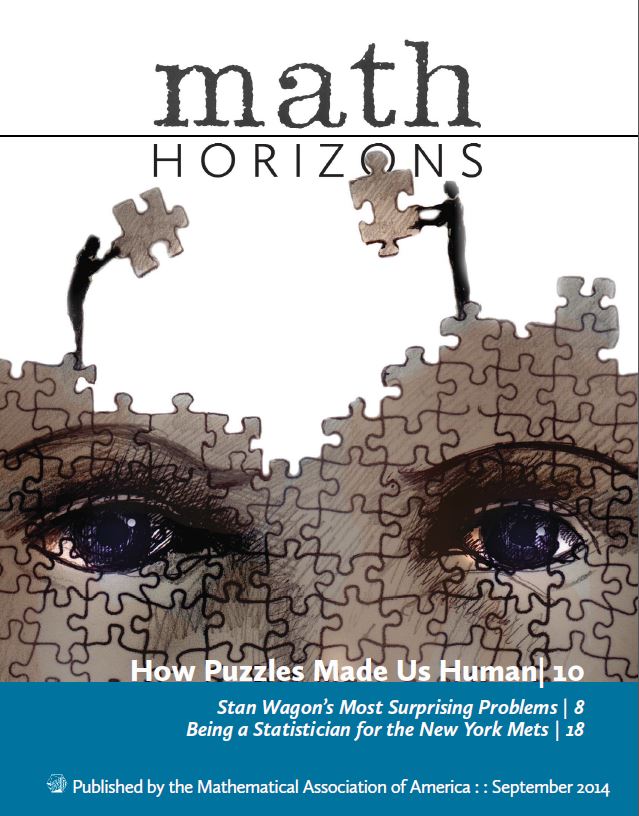- About MAA
- Membership
- MAA Publications
- Periodicals
- Blogs
- MAA Book Series
- MAA Press (an imprint of the AMS)
- MAA Notes
- MAA Reviews
- Mathematical Communication
- Information for Libraries
- Author Resources
- Advertise with MAA
- Meetings
- Competitions
- Programs
- Communities
- MAA Sections
- SIGMAA
- MAA Connect
- Students
- MAA Awards
- Awards Booklets
- Writing Awards
- Teaching Awards
- Service Awards
- Research Awards
- Lecture Awards
- Putnam Competition Individual and Team Winners
- D. E. Shaw Group AMC 8 Awards & Certificates
- Maryam Mirzakhani AMC 10 A Awards & Certificates
- Two Sigma AMC 10 B Awards & Certificates
- Jane Street AMC 12 A Awards & Certificates
- Akamai AMC 12 B Awards & Certificates
- High School Teachers
- News
You are here
Math Horizons Contents—September 2014
Math enthusiasts crave the exhilarating Aha! experience when solving a problem or puzzle. In this issue Pradeep Mutalik argues that this emotional problem-solving reward is what made us human. Longtime problem-poser Stan Wagon gives us plenty of Aha! moments as he shares his 10 most surprising problems. Baseball enthusiasts will also enjoy the double header in this issue. Tim Chartier, John Harris, and Kevin Hutson analyze how bad the situation was for the mighty Casey when he faced two strikes and no balls. And Ben Baumer writes about his time as a sabermetrician for the New York Mets.
Read these articles, and more, online today. Remember: Every MAA member has online access to Math Horizons.
Congratulations to Jordan Ellenberg, recipient of the 2014 Trevor Evans Award. Read his award-winning article "The Beauty of Bounded Gaps: A huge discovery about prime numbers and what it means for the future of mathematics."
Volume 22, Issue 1
JOURNAL SUBSCRIBERS AND MAA MEMBERS:
To read the full articles, please log in to the member portal by clicking on 'Login' in the upper right corner. Once logged in, click on 'My Profile' in the upper right corner.
The Travels of Two
Amy Shell-Gellasch
Ethiopian, Russian, and Egyptian cultures used doubling and halving to perform arithmetic.
JSTOR: http://dx.doi.org/10.4169/mathhorizons.22.1.5
Test Your Intuition
Stan Wagon
Longtime problem poser Stan Wagon shares his most surprising problems.
To purchase the article from JSTOR: http://dx.doi.org/10.4169/mathhorizons.22.1.8
How Puzzles Made Us Human
Pradeep Mutalik
The exhilarating Aha! moment we experience when solving a puzzle is an important human characteristic.
To purchase the article from JSTOR: http://dx.doi.org/10.4169/mathhorizons.22.1.10
THE VIEW FROM HERE: The Math behind College Admissions
James Cousins and Christian Millichap
Two students use their mathematical training to tackle the challenging problems of college admissions.
To purchase the article from JSTOR: http://dx.doi.org/10.4169/mathhorizons.22.1.14
To Swing, Or Not to Swing
Tim Chartier, John Harris, and Kevin Hutson
Just how bad did the mighty Casey have it, being down two strikes, no balls?
To purchase the article from JSTOR: http://dx.doi.org/10.4169/mathhorizons.22.1.16
Applied Mathematics at the Ballpark: The Life of One Sabermetrician
Ben Baumer
Ben Baumer writes about working as a statistician for his favorite baseball team. (pdf)
JSTOR: http://dx.doi.org/10.4169/mathhorizons.22.1.18
The Greatest Two-Point Answer Ever
William Dunham and Hank Sneddon
A first-year student proves a new theorem to earn two points on an exam.
To purchase the article from JSTOR: http://dx.doi.org/10.4169/mathhorizons.22.1.21
THE BOOKSHELF
Colm Mulcahy
Colm Mulcahy reviews Undiluted Hocus-Pocus: The Autobiography of Martin Gardner.
To purchase the article from JSTOR: http://dx.doi.org/10.4169/mathhorizons.22.1.24
DO THE MATH: Fibonacci Lemonade
Andrea Hawksley
Taste the Fibonacci sequence and the golden ratio in this delicious beverage.
To purchase the article from JSTOR: http://dx.doi.org/10.4169/mathhorizons.22.1.29
THE PLAYGROUND!
The Math Horizons problem section, edited by Gary Gordon
JSTOR: http://dx.doi.org/10.4169/mathhorizons.22.1.30
AFTERMATH: Bad at Math Is a Lie
Matt Waite
Despite what journalism professor Matt Waite told himself growing up, he is not Bad at Math.
To purchase the article from JSTOR: http://dx.doi.org/10.4169/mathhorizons.22.1.34





